Introduction
Living near green spaces has been shown to enhance human health and promote healthy behaviors (Mitchell and Popham 2008). Many studies have shown that interacting with nature can deliver a number of benefits including improved physical health, psychological well-being, cognitive ability, and social cohesion (Kaplan 2001; Ulrich 1984). In this rapidly urbanizing world, landscape plants serve as a convenient pathway for individuals to engage with nature. Due to Florida's subtropical climate, a vast array of diverse plant species is commonly used in home landscapes. However, it is important to note that many landscape plants can be toxic if consumed, posing risks to small children, pets, and livestock such as cattle, horses, or sheep. These plant species can still be utilized in the landscape, but it is important to understand which species are toxic to prevent accidental exposure, particularly in environments where small children or pets could inadvertently come into contact with them. This EDIS publication informs home gardeners, pest management professionals, and other plant enthusiasts of some of the most common plants in home landscapes in Florida, focusing particularly on poisonous species that could potentially cause harm if ingested.
Oleander (Nerium oleander)
Other Common Names
Rose laurel, Kaner, rosebay
Family
Apocynaceae
Lifespan
Perennial
Distribution and Habitat
Oleander is native to subtropical Asia and the Mediterranean region but is now found in many parts of the world including the United States (Vélez-Gavilán 2022). It thrives in USDA Plant Hardiness Zones 9a through 11, but frost can harm the plants in north Florida. It is one of the most widely cultivated ornamental species in the world (Figure 1). It is commonly found in tropical, subtropical, and warm temperate climates. In its native range, it is found growing along watercourses and around rocky streambeds (Henderson 1992). It prefers to grow in well-drained, fertile soil but can grow in a broad range of soil types. It is salt and drought tolerant, making it a colorful and suitable addition to beachside landscapes.
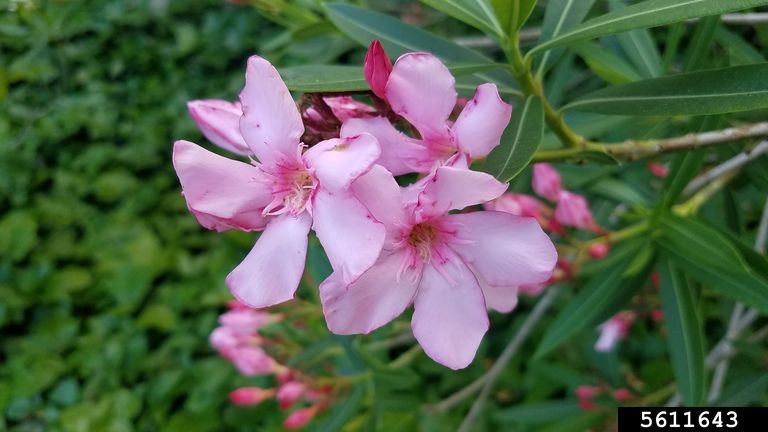
Credit: Rebekah D. Wallace, University of Georgia, Bugwood.org
Biology
Oleander is a fast-growing shrub or small tree that can grow from 6.5 to 19.5 feet tall. The leaves are dark green, are arranged in whorls of three or four, and can grow between 8 and 18 cm long. The flowers range in shades of white, pink, red, coral, and yellow (Figure 2). The plant typically blooms in spring and fall, but flowering may also occur year-round (Gilman et al. 2018). The fruits are cylindrical pods, 7 to 12 cm long, that contain hairy seeds.
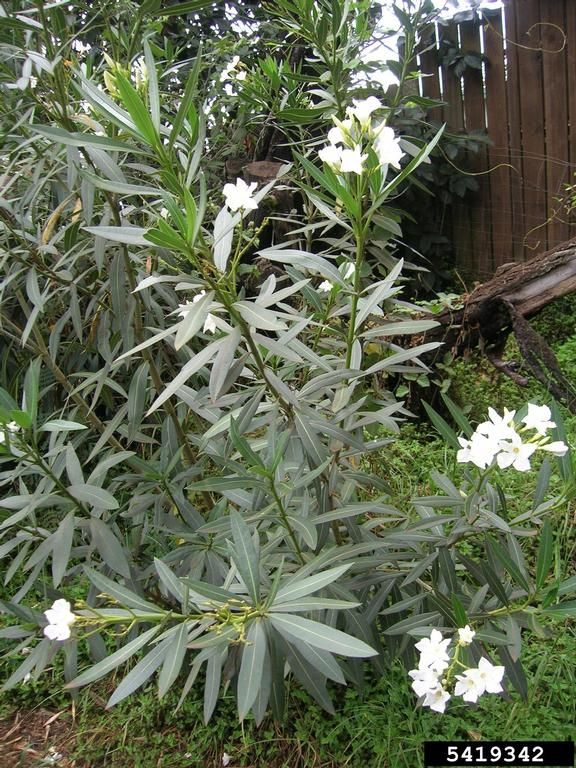
Credit: Forest and Kim Starr, Starr Environmental, Bugwood.org
Toxicity
All parts of the plant are poisonous to humans and animals. Ingestion, inhalation, or physical contact with the mucus membrane of oleander can result in adverse effects. The sap of its freshly cut leaves can cause contact dermatitis. Ingestion of any part of the plant can result in diarrhea, abdominal pain, headache, vomiting, nausea, and cardiovascular symptoms (Haynes et al. 1985). Several toxic compounds, such as oleandrin, oleandrigenin, and other cardiac glycosides, are present in the plant (Farkhondeh et al. 2020). If the disposed plant is burnt, the toxins can become airborne and cause respiratory difficulties if the smoke is inhaled. It is a highly prized and low-maintenance ornamental plant that makes a great addition to the landscape, but caution should be used by keeping this plant out of reach of small children, pets, or livestock.
Gloriosa Lily (Gloriosa superba)
Other Common Names
Cat’s claw, climbing lily, flame lily, tiger’s claw
Family
Colchicaceae
Lifespan
Perennial
Distribution and Habitat
Gloriosa lily is native to sub-Saharan Africa, the Indian subcontinent, and Southeastern Asia. It is the national flower of Zimbabwe and is considered a noxious weed in Australia and some parts of the United States. It can be grown as a perennial in USDA Plant Hardiness Zones 8 through 10. The plant prefers to grow in sandy loam soil but can tolerate nutrient-poor soils. It grows in various habitats, including forests, grasslands, and sandy coastal areas (Ade and Rai 2009).

Credit: John Ruter, University of Georgia, Bugwood.org
Biology
Gloriosa lily is a climbing or creeping plant that grows as a perennial in Florida and as a summer bulb in colder regions. The plant reproduces vegetatively via rhizomes (underground stems) and seeds. The leaves are hairless, shiny, and light or bright green. The leaves are oval-to-spear-shaped, are alternately arranged on the stem, and taper to a short tendril at the tip. The flowers are large and showy, with three sepals and three petals that are each about 5 to 7.5 cm long. The immature flowers are scarlet red or reddish orange with a yellow base (Figure 3). As the flowers mature, they transition to a dull red or purple hue. The plant typically blooms from summer to fall in Florida. The fruits are large capsules, measuring about 3 to 10 cm in length and 1 to 2 cm in width. When immature, the fruits are green to yellow, and as they mature, they darken to a dark-brown color.
Toxicity
All parts of the plant are poisonous to humans and animals. The leaves, flowers, and rhizomes are toxic if ingested. The tuberous roots are particularly high in toxicity and can be fatal if ingested. The plant contains several alkaloids, but the toxicity is attributed mainly to colchicine (Samanta and Kumar 2005). Symptoms can develop within two hours after ingestion and consist of vomiting; numbness of the lips, throat, and tongue; and bloody diarrhea. Two major symptoms that develop after two to three weeks of ingestion are alopecia and dermatitis (Ade and Rai 2009). In some cases, it can also cause contact dermatitis.
Sago Palm (Cycas revoluta)
Other Common Names
Cycad, Japanese sago palm, king sago palm
Family
Cycadaceae
Lifespan
Perennial
Distribution and Habitat
Sago palm is native to the Japanese island of Kyushu, the Ryukyu islands, and southern China. It is a popular ornamental plant in the subtropics of the United States, mainly in Florida, California, Georgia, and Puerto Rico (Northrop et al. 2022). The sago palm is adapted to USDA Plant Hardiness Zones 8 through 11. It grows well in full sun or partial shade but prefers bright, indirect sunlight. The plant is drought tolerant and does not thrive with overwatering or poor drainage. It also grows well in sandy loam soils but can tolerate a wide range of soil types. Sago palm can tolerate short periods of cold, with frost resulting in damage to the foliage.
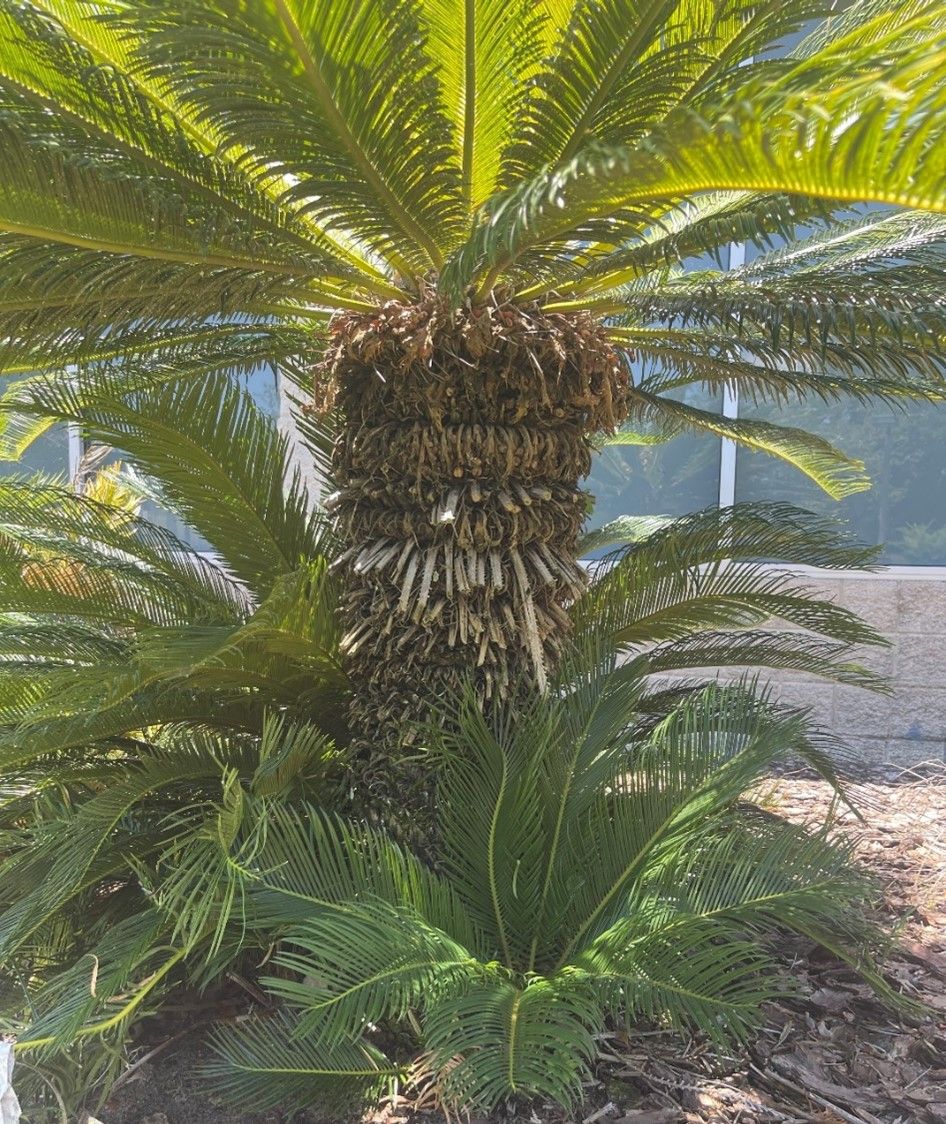
Credit: Yuvraj Khamare, UF/IFAS
Biology
The sago palm is not related to true palms, but rather, it resembles palm trees (Figure 4), which has led to the common name “sago palm.” It is often referred to as a living fossil because it belongs to the Cycadaceae plant family, which has survived on Earth for over 200 million years. It is an evergreen, slow-growing bush that can reach up to 15 feet in 50 years (Northrop et al. 2022). The leaves are dark green, palm-like, and shiny with spiny tips. The leaves can range from 20 to 60 inches long and are arranged in a rosette. The species name revoluta refers to the leaves of plants rolling downward. Its reproductive structures are present in the center of the plant, being either male or female. The male organ is a large yellow cone (Figure 5), whereas the female organ consists of a flowerhead shaped like a yellow furry globe (Figure 6). The female organ contains seeds that are bright orange to red in color and about 2 inches in diameter.
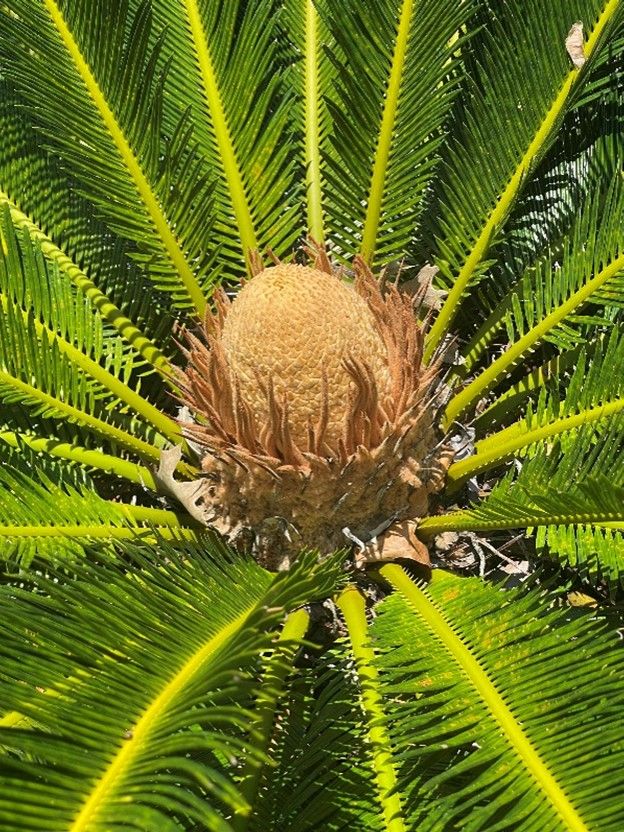
Credit: Yuvraj Khamare, UF/IFAS
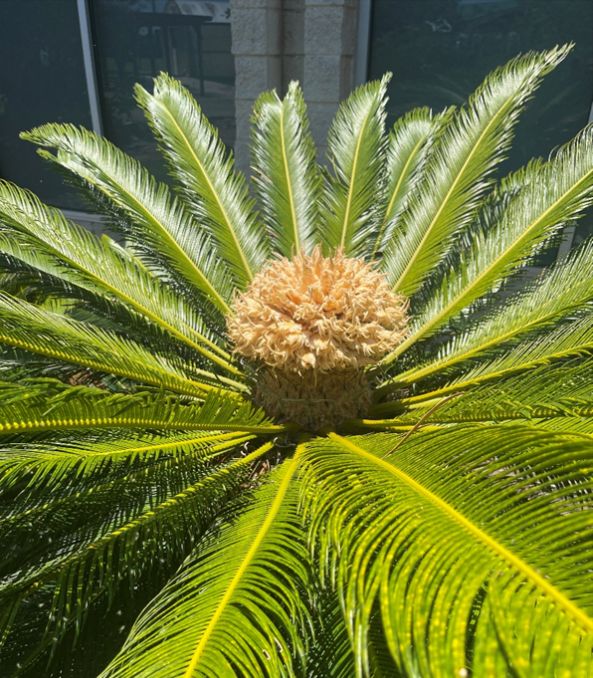
Credit: Yuvraj Khamare, UF/IFAS
Toxicity
All parts of the sago palm are highly toxic to humans and animals. All parts of the plant contain various toxins, namely cycasin, macrozamin, neocycasin, and beta-methylamino-1-alanine (Chang et al. 2004). Cycasin, a potent toxin present in all parts of the plant with seeds containing the highest concentration, has mutagenic and carcinogenic properties. Cycasin is considered present in all genera of Cycadales. Symptoms in both humans and animals develop within 12 hours of ingestion; they include vomiting, abdominal pain, diarrhea, headache, dizziness, and weakness.
Coontie (Zamia floridana)
Other Common Names
Coontie palm, Seminole bread, Florida arrowroot, wild sago
Family
Zamiaceae
Lifespan
Perennial
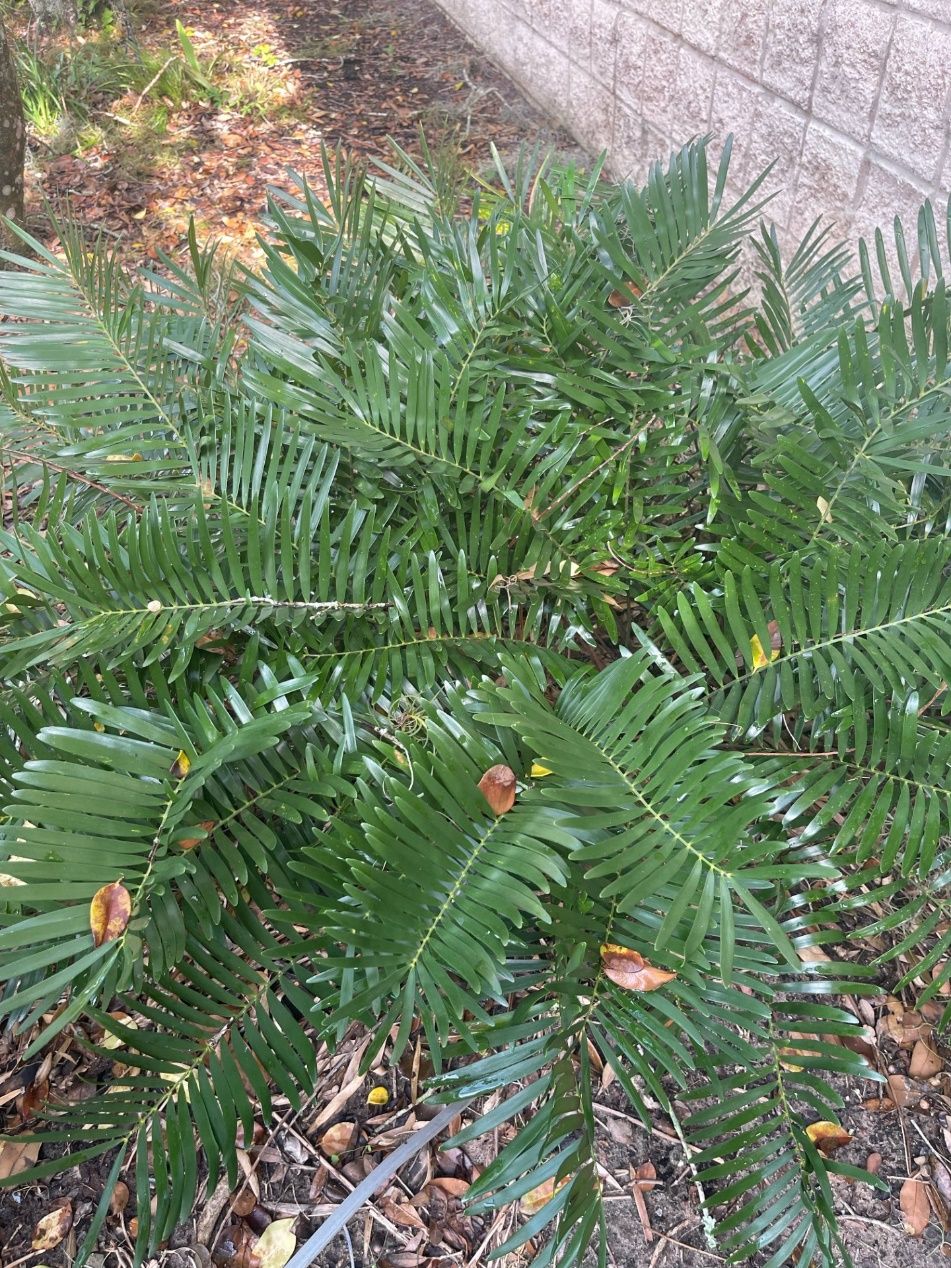
Credit: Yuvraj Khamare, UF/IFAS
Distribution and Habitat
Coontie is native to Florida, Georgia, and Puerto Rico. Around 30 species of Zamia are native to the American tropics and subtropics. Coontie grows well in USDA Plant Hardiness Zones 8b through 11. It is commonly found in pine-oak woodlands, on hammocks, and in areas with sandy loam soils. The plant grows well in full sun to partial shade. It is drought and salt tolerant, making it an excellent choice to use on the coast.
Biology
Coontie is a low-growing woody plant with a trunk growing underground or within a short distance above the ground (Figure 7). The plant unfurls like a fern and, eventually, forms clumps. The leaves are feather-like, linear to lanceolate in shape, 3 to 9 inches long, and 0.5 inches wide (Figure 8). The foliage emerges from the underground storage root, which is an extension of the above-ground stem. It is a cone-bearing gymnosperm with male and female cones on different plants. The male cones are cylindrical, whereas the female cones are elongated ovoid. Each cone scale consists of two drupelike, bright-orange seeds. It is the only plant that is a larval host to the Atala butterfly.

Credit: Yuvraj Khamare, UF/IFAS
Toxicity
All parts of the plant are poisonous, with seeds being the most toxic. The principal toxins present in the plant consist of cycasin, glycoside, and B-methylamino-l-alanine. Symptoms include dark stools, vomiting, headache, stomach pain, diarrhea with blood, liver failure, and, in some cases, death.
Angel’s Trumpet (Brugmansia sp.)
Other Common Names
Angel’s trumpet, tree daturas
Family
Solanaceae
Lifespan
Perennial
Distribution and Habitat
Angel’s trumpet is a small tropical tree native to South America, mainly the Andes. In its natural habitat, the plant grows on sloping terrain with warm, humid days and cool nights. It is well adapted to USDA Plant Hardiness Zones 9 through 11. The plant does well in shaded areas and can show signs of stress under full sun. The plant tolerates light drought, frost, and salt.
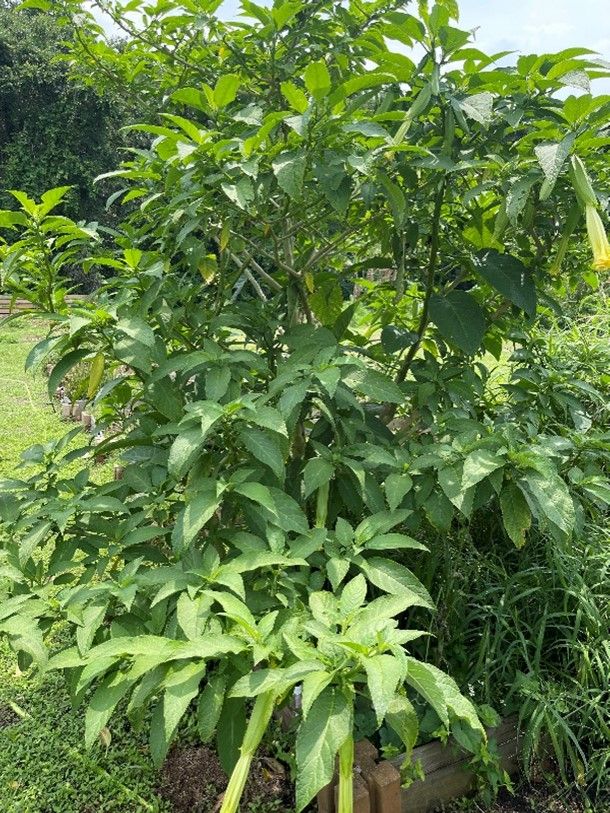
Credit: Yuvraj Khamare, UF/IFAS
Biology
Angel’s trumpet was once included in the genus Datura but is recognized now in its own genus, Brugmansia (Kerchner and Farkas 2019). Brugmansia consists of seven species and several hybrids. The plant can grow to a height of up to 30 feet tall in tropical and subtropical climates (Figure 9). The leaves are alternately arranged along the stems and have a wide range in shape, appearing either toothed or entire (Figure 10). The individual blooms range in size from 4 to 24 inches long, depending on the species/cultivar. The flowers are large, pendant, and trumpet-shaped (Figure 11). The flower colors range in shades of pink, orange, white, yellow, gold, peach, and pink. Some cultivars bloom every six to eight weeks, others flower throughout the season, and some only bloom during cool weather. Most of the species are fragrant at night and pollinated by moths.

Credit: Yuvraj Khamare, UF/IFAS
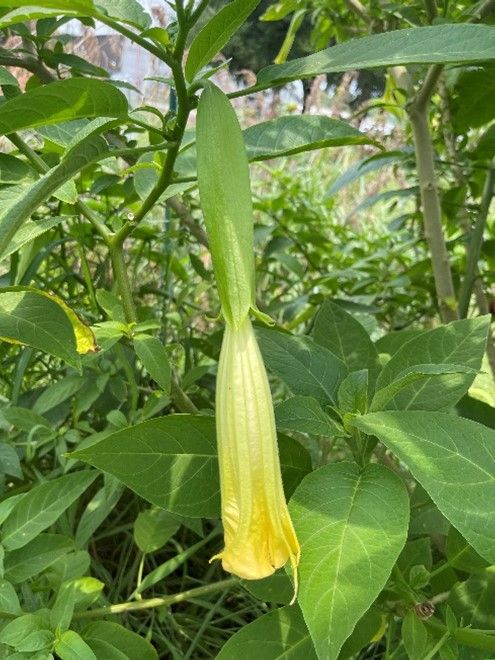
Credit: Yuvraj Khamare, UF/IFAS
Toxicity
All the parts of the angel’s trumpet are poisonous. The plant contains a significant number of alkaloids, including atropine, hyoscine, hyoscyamine, and norhyoscine. Symptoms include dilated pupils, blurred vision, confusion, hallucinations, increased blood pressure and heart rate, dryness of skin, and suppressed salivation (Goldfarb et al. 2018).
Golden Dewdrop (Duranta erecta)
Other Common Names
Pigeon berry, skyflower
Family
Verbenaceae
Lifespan
Perennial
Distribution and Habitat
Golden dewdrop is said to be native to tropical and subtropical Americas. In its native range, it grows in rocky and coastal areas under full sun or on disturbed sites inland. It is an invasive species in China, Taiwan, Australia, and Fiji (Arengo 2015). The plant thrives in USDA Plant Hardiness Zones 9B through 11. It grows best in full sun but can tolerate partial shade as well. It prefers to grow in well-drained, fertile soil and is moderately salt tolerant.
Biology
Golden dewdrop is an evergreen shrub that sometimes also grows as a small tree. The plant grows in a drooping habit with a height ranging from 10 to 20 feet tall. The stems of mature plants have thorns that are absent in younger plants. The leaves are oval with serrated margins, opposite, and bright green. The flowers are small, clustered, and tubular; they come in various colors, including purple, white, violet, or blue (Figure 12). The fruits are round, measure 7 to 10 mm in diameter, and grow in clusters of orange-to-yellow colors (Figure 13).
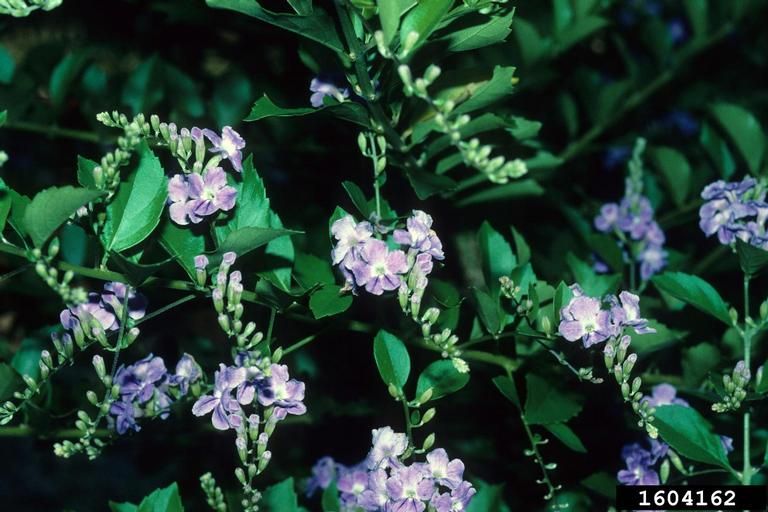
Credit: John Ruter, University of Georgia, Bugwood.org
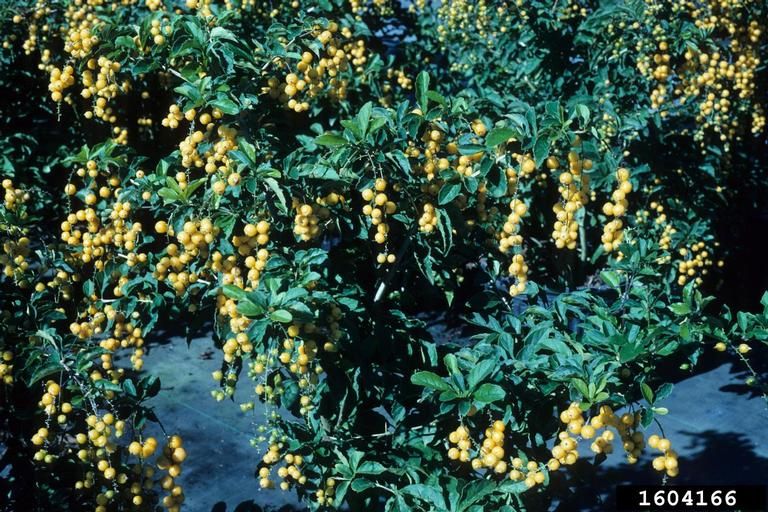
Credit: John Ruter, University of Georgia, Bugwood.org
Toxicity
The leaves and fruits (berries) are highly toxic. There have been several confirmed cases of dogs and cats killed by consuming the leaves and berries (Thomson 2007). Several toxic compounds are present in the leaves and fruit, such as isoquinoline, saponin glycoside, hydrocyanic acid, and durantoside. Symptoms include drowsiness, fever, nausea, vomiting, and seizures.
Yesterday, Today, and Tomorrow (Brunfelsia grandiflora)
Other Common Names
Kiss-me-quick, royal purple brunfelsia
Family
Solanaceae
Lifespan
Perennial
Distribution and Habitat
Yesterday, today, and tomorrow is native to Brazil, Bolivia, Peru, Ecuador, and Colombia. It is commonly used as a hedge plant and makes a great container plant. The plant thrives in USDA Plant Hardiness Zones 9B through 11. The plant prefers to grow in filtered light and does well in full shade. The plant also thrives and flowers in low-light conditions. It can tolerate drought but needs regular water when blooming.
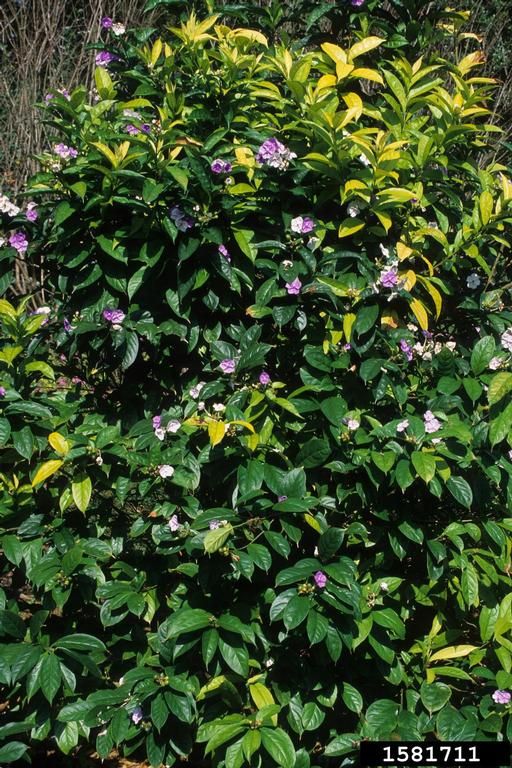
Credit: John Ruter, University of Georgia, Bugwood.org
Biology
Yesterday, today, and tomorrow is a flowering shrub or small tree in the nightshade family. The plant grows up to 10 feet tall (Figure 14). The shrub has dense foliage with alternately arranged leaves. The leaves are simple, green, and up to 12 inches long. The flowers are lavender, purple, or white in color. They bloom nearly year-round in Florida and have a pleasant fragrance. The flowers open as a rich lavender or blue color and change to a pale, almost white before the fall (Figure 15). The fruits are woody berries that turn brown when mature and contain numerous seeds.
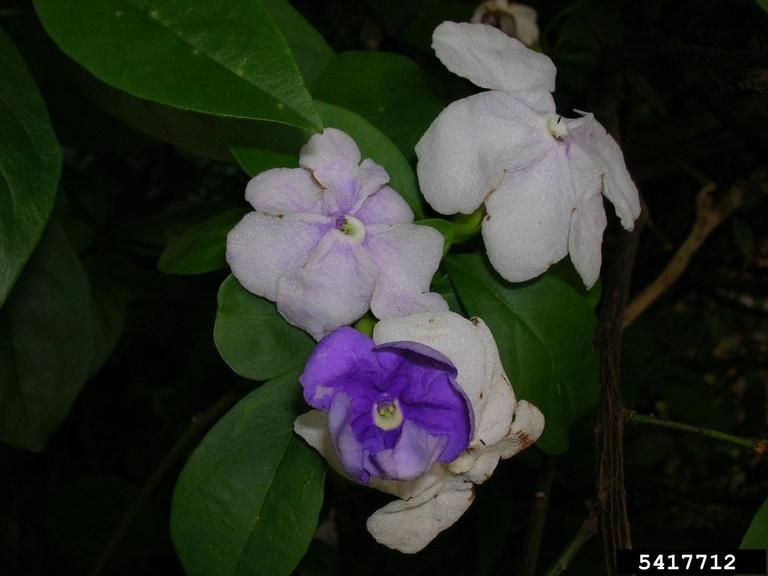
Credit: Forest and Kim Starr, Starr Environmental, Bugwood.org
Toxicity
All parts of the plant are considered highly poisonous. Dogs, cats, and children are attracted particularly to the berries and flowers, but the berries are highly toxic. The principal toxin present in the plant is brunfelsamidine. Early symptoms consist of vomiting, coughing, and diarrhea. These symptoms can be followed by tremors, seizures, and difficulty walking. Changes in blood pressure and heart rate can also be experienced.
Common Lantana (Lantana camara)
Other Common Names
Lantana, red sage, shrub verbena, yellow sage
Family
Verbenaceae
Lifespan
Perennial
Distribution and Habitat
Common lantana is native to tropical and subtropical America. It is one of the most popular landscape plants as it is heat, salt, and drought tolerant. It can grow in USDA Plant Hardiness Zones 7 through 11. The plant prefers well-drained soil and thrives in sandy loam soil found in Florida. The plant does well in full sun and quickly invades disturbed sites. The UF/IFAS Assessment of Non-Native Plants categorizes common lantana as invasive, although several sterile varieties are available in the market. It is also regarded as one of the 10 most noxious weeds in the world (Sharma et al. 1988).
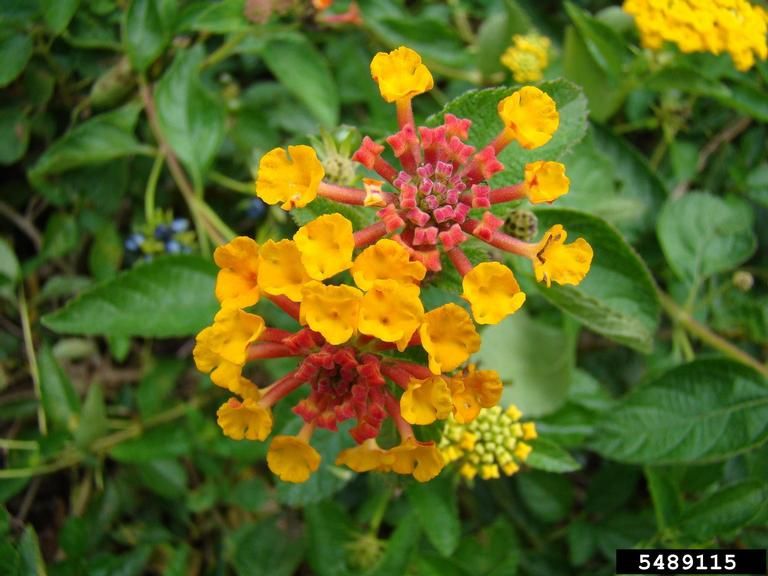
Credit: Rebekah D. Wallace, University of Georgia, Bugwood.org
Biology
Common lantana is a medium-sized shrub that can grow up to 17 feet tall. The plant can be sub-erect, scrambling, or climbing. The leaves are ovate, oppositely arranged, and aromatic when crushed. The leaves also have a sandpaper-like texture and are about 6 inches in length and 2.5 inches across. The plant features small, tubular-shaped flowers clustered at the ends of the stems. These flowers come in a variety of colors, including red, yellow, white, pink, and orange (Figure 16). The color variation depends on the age of the flower, with mature ones predominantly darker in color. In Florida, the plant flowers year-round, and a single plant has the potential to produce 12,000 fruits. The fruits are round, measure 0.2 inches in diameter, and change color from green to black when mature (Figure 17). The plant can produce both vegetatively and via seeds.

Credit: Rebekah D. Wallace, University of Georgia, Bugwood.org
Toxicity
All parts of the plant are poisonous, particularly to livestock. There are many cases of animals such as cattle, horses, sheep, guinea pigs, and rabbits being affected by lantana. Children can also be poisoned by eating the berries of the plant. The principal toxin present in lantana are the two triterpene acids, lantadene A and lantadene B. The lantadenes are primarily found in leaves and have different harmful effects on different mammals and livestock species (Ntalo et al. 2022). Signs and symptoms of lantana poisoning depend on the amount of the plant consumed. The symptoms consist of excessive skin sensitivity to sunlight, liver damage, jaundice, swelling of ears and eyelids, and reddening and discharge from eyes. Lantana toxicity primarily affects the liver and kidneys and can, in some cases, result in the death of livestock within two to four days.
Day Lily (Hemerocallis spp.)
Other Common Names
Day lilies, daylily
Family
Hemerocallidaceae
Lifespan
Perennial
Distribution and Habitat
Hemerocallis spp. is primarily native to East Asia, with the main diversity of the genus found in China, Korea, and Japan (Manole 2018). In its native range, the members of the genus are normally found in mountains and grassland habitats. The day lily is incredibly versatile and thrives in USDA Plant Hardiness Zones 3 through 9. The plant does well in full sun but can tolerate light shade. The flowers grow best with a minimum of six hours of direct sun. The plant prefers to grow in slightly acidic, moist, and well-drained soil that is high in organic matter. This perennial flowering plant is widely favored and thrives in Florida landscapes.
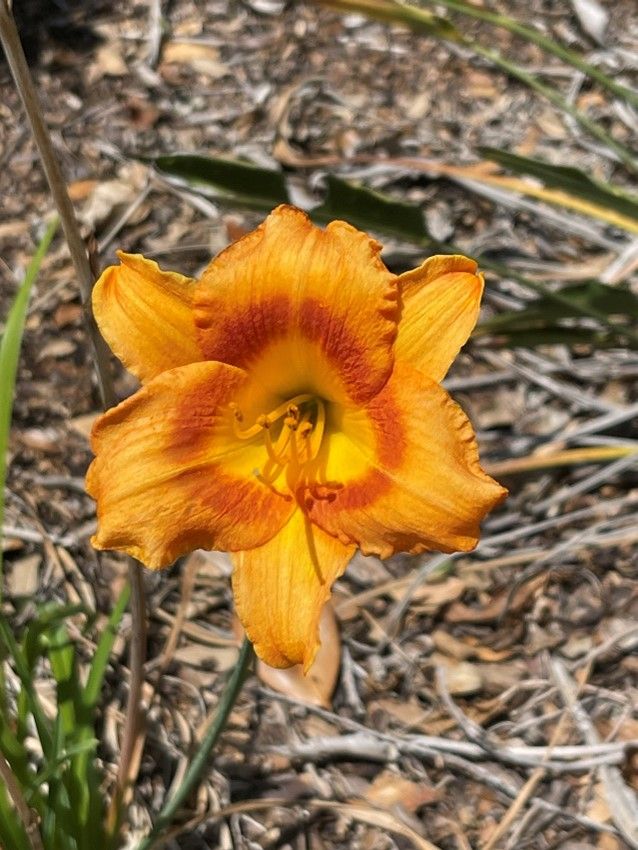
Credit: Yuvraj Khamare, UF/IFAS
Biology
Day lilies are not true lilies and belong to the genus Hemerocallis. The plant has long and linear leaves that arise from a perennial fleshy rhizome at ground level. The rhizome generates fleshy roots that develop into densely thickened, tuberous reserve structures. The flowers are showy and trumpet-shaped; their colors includes yellow, orange, red, pink, purple, white, and various combinations (Figure 18). Early-season bloomers typically flower in March, whereas late bloomers will blossom after May. The genus Hemerocallis derives from the Greek words "Hemero," meaning day, and "callis," signifying beauty. The fruit are loculicidal capsules that dry and split when the seeds are ripe (Figure 19).
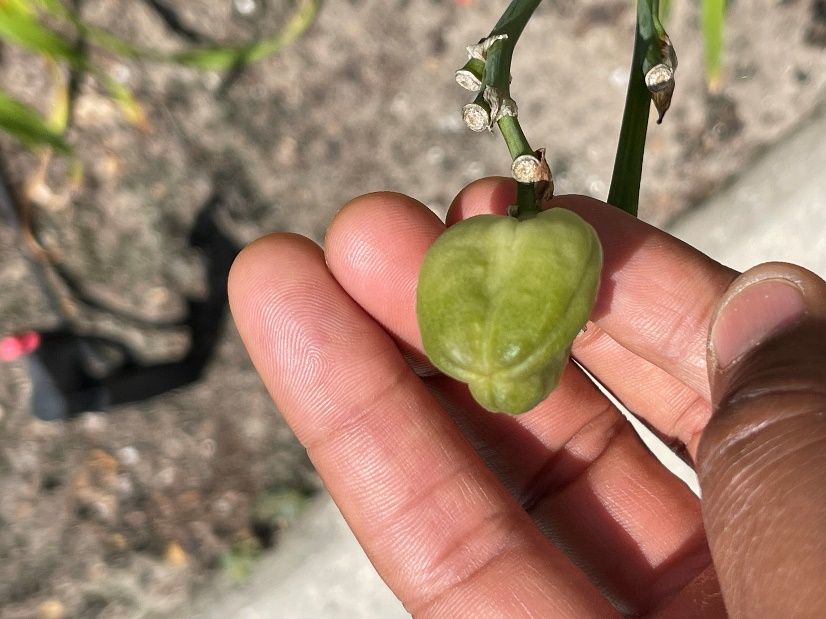
Credit: Yuvraj Khamare, UF/IFAS
Toxicity
All parts of the plant are toxic to dogs and cats. Even a small amount of plant material can cause serious concerns if ingested. The mechanism of the toxicity is still unknown, but it is known to cause acute kidney injury in cats. Symptoms include gastrointestinal irritation, followed by dehydration, vomiting, and then renal failure (Bates 2016). Seizures can also occur in some cases.
Azaleas (Rhododendron and Azalea spp.)
Other Common Names
Azaleas, rhododendron
Family
Ericaceae
Lifespan
Perennial
Distribution and Habitat
Rhododendron is a genus of more than 1000 species. Most of the species are native to Asia, while a small number are native to North America, Europe, and Australia. They grow in the wild from the Arctic region to the tropics. Azaleas are widely distributed across the United States, flourishing in USDA Plant Hardiness Zones 5 through 9. Azalea is considered a subgenus of Rhododendron. Rhododendron and azaleas thrive in naturally acidic soils, moderate humidity and wind, and sufficient water availability. They are widely used to enhance the home landscape as a foundation or mass planting and as a background or hedge plant.

Credit: Dow Gardens, Dow Gardens, Bugwood.org
Biology
Rhododendron grows into large shrubs or small trees, ranging in height from 40 inches to 30 feet tall. They can be either evergreen or deciduous plants (Figure 20). The leaves are simple, alternate, and leathery; they can range in size from 0.8 to 20 inches. The flowers are produced in large, showy clusters and in several colors, such as white, red, pink, and purple (Figure 21). The fruit are generally elongated capsules that split into five sections to release small, scale-like seeds.

Credit: Dow Gardens, Dow Gardens, Bugwood.org
Toxicity
Rhododendron spp. contains a toxin called grayanotoxin glycosides. This toxin is present in all parts of the plant, including the flowers and nectar. Grayanotoxin affects the sodium channels in the cell membrane, leading to neurologic, gastrointestinal, and cardiovascular dysfunction. Poisoned animals initially show signs of digestive stress, such as anorexia, excessive salivation, vomiting, and frequent defecation. There are many poisoning cases reported in people who have consumed tea made from their flowers or “mad honey” made by bees feeding on rhododendron (Koca and Koca 2007). Symptoms in humans include depression, vomiting, painful neck, slow and erratic heart rate, and weakness.
Conclusion
Note that this publication is not a comprehensive list of potentially toxic landscape plants, but it represents many common ornamentals that can be toxic if ingested. Even if a plant is toxic, there is usually no need to avoid using the species in the landscape. Many of the plants discussed in this publication offer numerous other benefits (food for wildlife, pollinator habitat, etc.) and aesthetic appeal. However, it is important to exercise caution and keep small children or pets from ingesting any of these toxic plants or any other plants in which the toxicity is unknown.
References
Ade, R., and M. K. Rai. 2009. “Current Advances in Gloriosa superba L.” Biodiversitas Journal of Biological Diversity 10 (4). https://doi.org/10.13057/biodiv/d100409
Arengo, E. 2015. “Duranta erecta (Golden Dewdrop).” CABI Compendium. https://doi.org/10.1079/cabicompendium.20192
Bates, N. 2016. “Lily Poisoning.” Companion Animal 21 (4): 238–241. https://doi.org/10.12968/coan.2016.21.4.238
Chang, S., Y. Chan, M. Wu, et al. 2004. “Acute Cycas Seed Poisoning in Taiwan.” Journal of Toxicology: Clinical Toxicology 42 (1): 49–54. https://doi.org/10.1081/CLT-120028744
Farkhondeh, T., M. Kianmehr, T. Kazemi, S. Samarghandian, and M. R. Khazdair. 2020. “Toxicity Effects of Nerium oleander, Basic and Clinical Evidence: A Comprehensive Review.” Human & Experimental Toxicology 39 (6): 773–784. https://doi.org/10.1177/0960327120901571
Gilman, E.F., D. G. Watson, R. W. Klein, A. K. Koeser, D. R. Hilbert, and D. C. McLean. 2018. “Nerium oleander: Oleander.” ENH-571. University of Florida Institute of Food and Agricultural Sciences. https://edis.ifas.ufl.edu/publication/ST412
Goldfarb, J., N. Pesin, and E. Margolin. 2019. “Gardening and Dilated Pupils: An Interesting Case of Anisocoria from Brugmansia versicolor.” Canadian Journal of Ophthalmology 54 (2): 59–61. https://doi.org/10.1016/j.jcjo.2018.05.004
Haynes, B. E., H. A. Bessen, and W. D. Wightman. 1985. “Oleander Tea: Herbal Draught of Death.” Annals of Emergency Medicine 14 (4): 350–353. https://doi.org/10.1016/S0196-0644(85)80103-7
Henderson, L. 1992. “Oleander: An Invasive Riverside Shrub from the Mediteranean.” Veld & Flora 78 (3): 84–86.
Kaplan, R. 2001. “The Nature of the View from Home: Psychological Benefits.” Environment and Behavior 33 (4): 507–542. https://journals.sagepub.com/doi/abs/10.1177/00139160121973115
Kerchner, A., and Á. Farkas. 2020. “Worldwide Poisoning Potential of Brugmansia and Datura.” Forensic Toxicology 38: 30–41. https://doi.org/10.1007/s11419-019-00500-2
Koca, I., and A. F. Koca. 2007. “Poisoning by Mad Honey: A Brief Review.” Food and Chemical Toxicology 45 (8): 1315–1318. https://doi.org/10.1016/j.fct.2007.04.006
Manole, S. 2018. “Improvement of Daylilies (Hemerocallis L.) in the Republic of Moldova.” Lucrări Ştiinţifice. Seria Horticultură: 83–90.
Mitchell, R., and F. Popham. 2008. “Effect of Exposure to Natural Environment on Health Inequalities: An Observational Population Study.” The Lancet 372 (9650): 1655–1660. https://doi.org/10.1016/S0140-6736(08)61689-X
Northrop, R. J., M. G. Andreu, M. H. Friedman, M. McKenzie, and H. V. Quintana. 2010. “Cycas revoluta, Sago Palm: FOR 254/FR316, 5/2010.” EDIS 2010 (4). https://doi.org/10.32473/edis-fr316-2010
Ntalo, M., K. E. Ravhuhali, B. Moyo, O. Hawu, and N. H. Msiza. 2022. “Lantana camara: Poisonous Species and a Potential Browse Species for Goats in Southern Africa—A review.” Sustainability 14 (2): 751. https://doi.org/10.3390/su14020751
Samanta, A. K., and K. U. Kumar. 2005. “Poisoning by Glory Lily-A Case Report.” Journal of Indian Academy of Forensic Medicine 27 (3): 188–189.
Sharma, O. P., H. P. S. Makkar, and R. K. Dawra. 1988. “A Review of the Noxious Plant Lantana camara.” Toxicon 26 (11): 975–987. https://doi.org/10.1016/0041-0101(88)90196-1
Thomson, N. 2007. “Poisonous and Invasive Plants in Australia: Enabling Consumers to Buy Safe Plants.” WWF-Australia Issues Paper. WWF-Australia. Archived January 10, 2024, at https://web.archive.org/web/20140110103830/http://awsassets.wwf.org.au/downloads/sp127_poisonous_and_invasive_plants_in_australia_1jul07.pdf
Ulrich, R. S. 1984. “View through a window may influence recovery from surgery.” Science 224 (4647): 420–421. https://doi.org/10.1126/science.6143402
Vélez-Gavilán, J. 2022. “Nerium oleander (oleander).” CABI Compendium. https://doi.org/10.1079/cabicompendium.36220